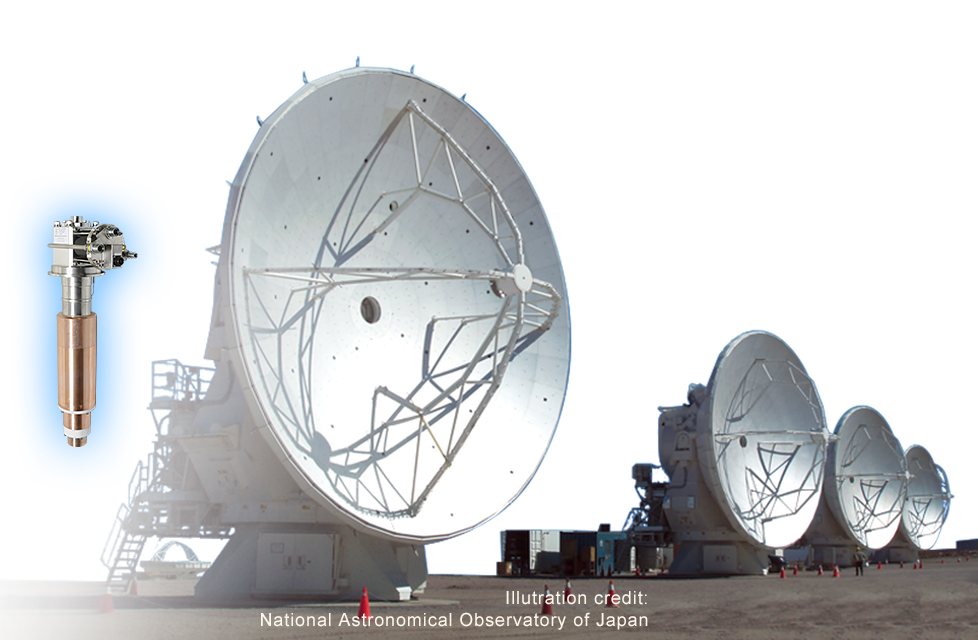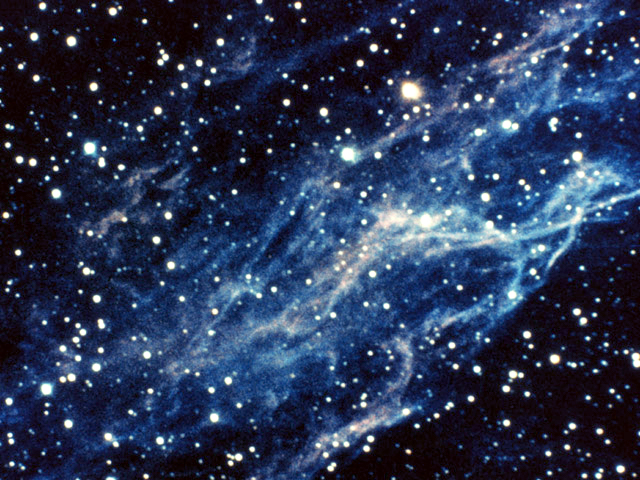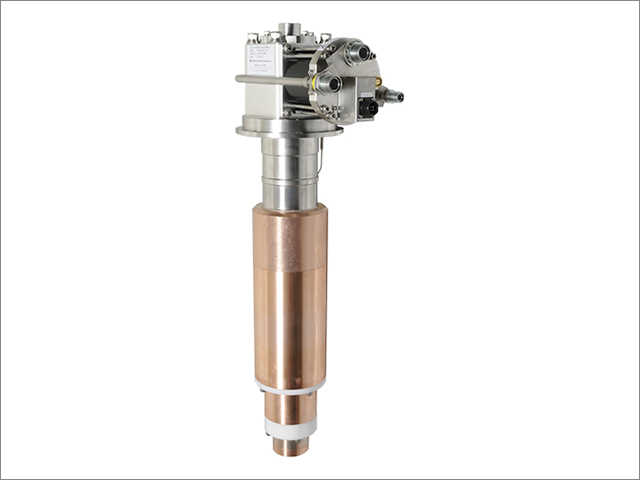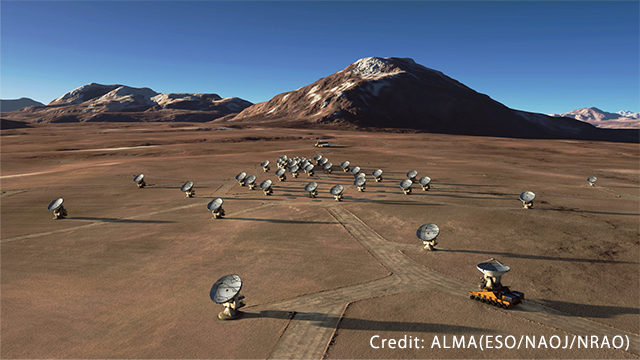A Clear View of the Distant Heavens

To gain an understanding of how the universe began, it is necessary to observe precisely the dark reaches of space that are so distant that no light from them reaches us. Radio telescopes play an important role in this endeavor. In order to achieve a sufficiently high capacity to receive the extremely weak radio waves involved, the receiver must be chilled to a temperature of around minus 270°C. This makes it possible to eliminate as far as possible noise generated by heat or by variations in temperature. The type of equipment used to produce such very low temperatures is called a cryogenic freezer. The ALMA Telescope Project currently underway in the highlands of South America, utilizes cryogenic technology from the SHI Group.
Capturing Minute Radio Waves from the Dark Reaches of Space

To enable telescopes to see ever farther and more clearly, it has been necessary to enlarge their diameter more and more. there are limits to how large a single telescope can be, however. For example, it would probably be impossible to build a radio telescope dish 1 kilometer in diameter. It is possible, however, by combining observation data from multiple radio telescope dishes, to build a virtual telescope with a diameter equal to the distance between the dishes. This technique, known as radio interferometry, enables higher resolution than was previously attainable and makes it possible to observe the farthest reaches of space in great detail.
An international project, the ALMA (Atacama Large Millimeter/submillimeter Array) Telescope is presently under construction at an elevation of 5,000 meters above sea level in the Atacama Desert in Chile, South America. It consists of 66 parabolic antennas arranged in an array covering a maximum distance of 18.5 km. Its resoling power is said to be about 10 times that of the Subaru Telescope in Hawaii or the Hubble Space Telescope, and it is capable of capturing minute radio waves from the dark reaches of space.
Cryogenic freezers from SHI are used to cool the receiving equipment of the ALMA Telescope.
Three-Stage Structure to Maximize Cooling Capacity

Radio telescopes can't abide the electromagnetic noise produced by human activity. In addition, oxygen and water vapor in the atmosphere absorb radio signals at very short wavelengths, so radio telescopes work best when located on high ground where the air is thin and dry. This is why the Atacama Plateau was selected as the place to build the ALMA Telescope.
It is also necessary to boost the performance of the sensors used in order to capture the very weak radio waves that reach Earth from space. The generally used method to reduce the effects of thermal noise on the sensors is to chill the sensors themselves to extremely low temperatures.
Previously, cryopumps (vacuum pumps) designed for semiconductor manufacturing equipment and SHI freezers for applications such as medical MRI systems where used to cool the ALMA sensors. Such cooling systems are already in service in radio telescope applications such as the Nobeyama Radio Observatory of the National Astronomical Observatory of Japan.
The new freezers employ a three-stage structure to reduce noise and optimize cooling capacity. The first stage cools a large shield panel, and the second stage cools a low-noise amplifier. This configuration suppresses heat conduction and radiation from the lead wires. As a result, most of the chilling capacity of the freezer can be used to cool the sensors mounted on the third stage. The multichannel design allows more than one sensor to be mounted on the stage.
Compact Design and Reduced Temperature Variation to Conquer a Harsh Environment

Designing the three-stage structure of the freezer required a great deal of effort. In particular, an extensive process of trial and error was involved in fashioning the portions that would determine the size of the freezer cylinder, while considering the thermal balance overall. Along the way the idea arose to use two units in tandem. Using two units definitely would boost the cooling performance, but at the same time it would make it more difficult to maintain thermal balance. It also had the disadvantage of making the system much larger. It was extremely important to make the telescope components as compact as possible because they were to be installed at a desolate highland site rarely visited by humans. The SHI Group brought to bear all its accumulated expertise in freezer design and in the end somehow managed to meet the stringent requirements.
Another important factor related to observation performance was reducing the thermal amplitude above the mounting stage. Variations in electrical resistance caused by temperature changes can be a fatal source of noise. To solve this problem, SHI engineers adopted a proposal to completely cover the mounting area of the third stage with a "helium pot," a sealed enclosure filled with helium gas. This innovation enables the freezer to maintain a stable absolute temperature above the mounting stage of 4.2 K (-268.95°C).
The ALMA Telescope will start full-scale operation in 2012. Once observation gets underway we should be able to catch a glimpse of what the Milky Way looked like shortly after it came into being and to gain a better understanding of the composition of organic molecules floating through space. This may help scientists to further unravel the mysteries of the universe, such as how the solar system and the Milky Way galaxy formed or where the materials that form the building blocks of life on Earth came from.
The new cryogenic freezer is only a small component when compared to the totality of a giant parabolic antenna with a diameter of up to 12 meters. Nevertheless, it is an essential device in our quest to learn about the origins of the universe.
- *All contents are as of the time of the interview.
SHI Pride
- Vol.1 A Clear View of the Distant Heavens
- Vol.2 Cures without Surgery: Advanced Cancer Treatment
- Vol.3 Exploring the Mysteries of Space
- Vol.4 Dramatically Changing Quayside Cargo Handling
- Vol.5 Cyclo Drives Continue to Evolve
- Vol.6 The Steam Turbine - Protecting the Environment and Advancing Society
- Vol.7 Persistent Determination to Reduce Defects, Losses and Faults to Zero
- Vol.8 Treating Cancer through the Use of Neutrons - A Compact Accelerator Opens the Door to Widespread Use -
- Vol.9 Automated storage system with unrestricted movement, for transforming the future of the logistics industry
- Vol.10 Anaerobic Wastewater Treatment and Biogas Power Generation System using Ume Seasoning Effluent bringing Recycling-Friendly Society
- #01 Technology that has the potential to dramatically change automobile frame manufacturing STAF created by maintaining a comprehensive customer perspective
- #02 The ECY Series:A smaller Gear reducer after over 10 years of development
- #03 Cancer Therapy System "Boron Neutron Capture Therapy (BNCT system)"
- #04 Supporting Development with Innovative Simulation Technology: RMD and MBM
- #05 Behind the Development of the World's Highest Output Accelerator for Proton Beam Cancer Therapy - Succeeding "When It Can't Be Done."
- #06 AI-backed support system for next generation biomass power plant operations ~ Transforming the shop floor with IZANA ~
